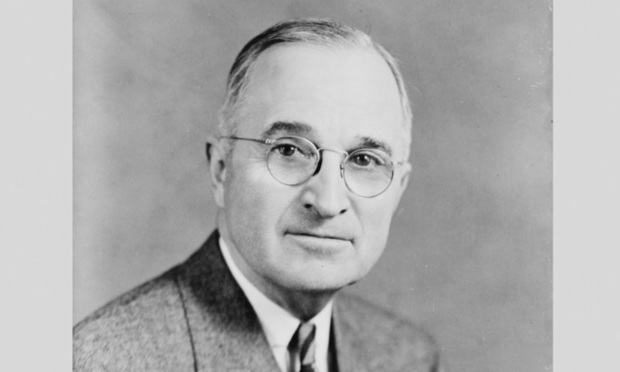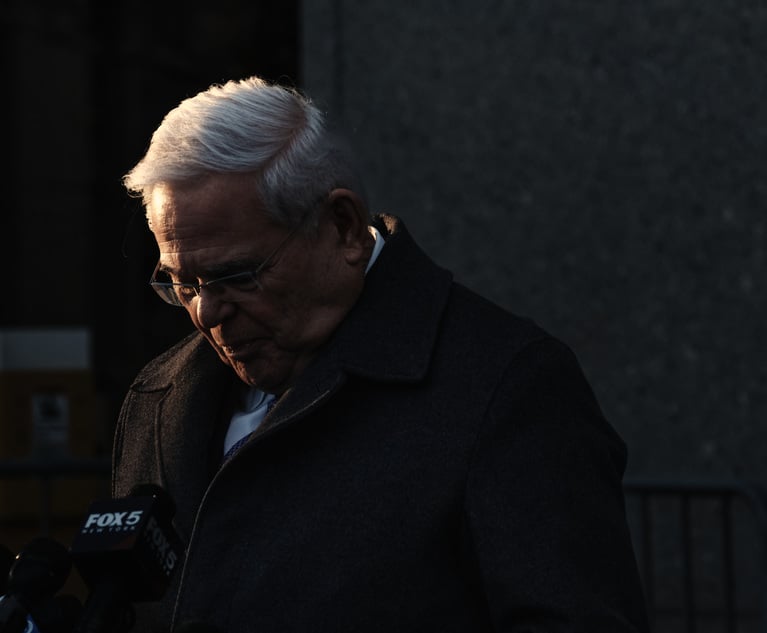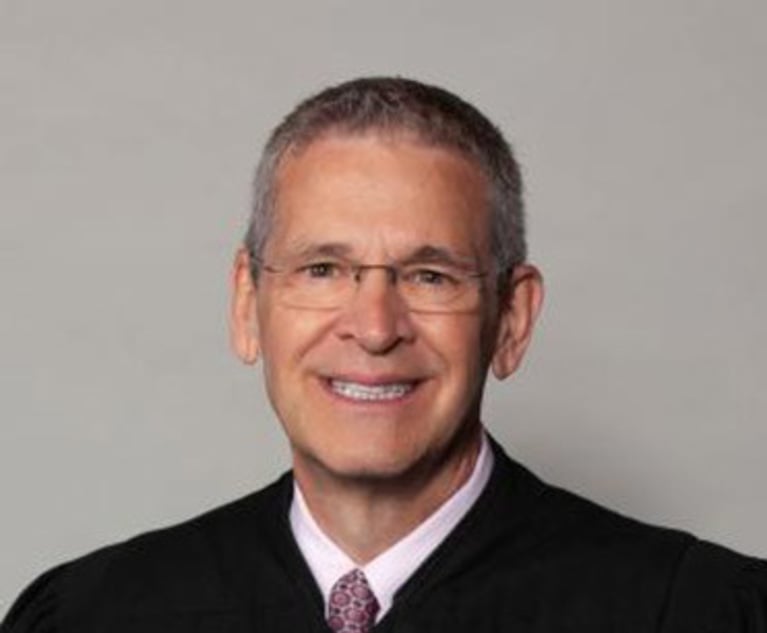President's Emergency Power is Limited
Under Youngstown, Congress's delegation of emergency power to spend for non-appropriated purposes should be narrowly construed in order to preserve the power of the purse.
March 01, 2019 at 05:05 PM
5 minute read
 President Harry S. Truman in 1945 / Photo: Edmonston Studio via Library of Congress
President Harry S. Truman in 1945 / Photo: Edmonston Studio via Library of Congress
Most of the discussion of President Trump's proclamation of a national emergency has been focused on whether any emergency exists at the border and whether or by what standard the courts can review the existence of a national emergency. That raises issues of the scope of the president's executive power under Article II of the Constitution that have never been considered or decided by the federal courts. The leading Supreme Court decision on presidential emergency power, Youngstown Sheet & Tube Corp. v. Sawyer, assumed that President Truman's declaration of national emergency at the start of the Korean War was in effect. It held that the emergency did not give the president the power to seize the steel industry, in order to forestall a strike, when Congress had explicitly denied that power and enacted a less intrusive alternative when it passed the Taft-Hartley Act. The most influential aspect of Youngstown, Justice Jackson's concurrence, postulates a three-level hierarchy of emergency powers under Article II: when the president's action exercises power delegated by Congress (as was the case in Trump v. Hawaii), when Congress is silent, and when presidential action conflicts with Congress. In the last case, wrote Jackson, presidential emergency power is at its lowest ebb. If the Supreme Court follows Jackson, it may well conclude that the current proclamation does not authorize the president to spend to build border barriers beyond what Congress has already appropriated for that purpose.
The 1976 National Emergencies Act uses Jackson's Youngstown hierarchy to confine the president's emergency powers. It provides, first, that any declaration of national emergency must specify pre-existing statutes that grant emergency power, and then that only the emergency powers in the specified statutes may be exercised. 50 U.S.C. § 1631. Thus the act both grants emergency power in the incorporated statutes and denies emergency power beyond them. Any attempt to exercise broader powers would conflict with Congress's expressed will.
The current proclamation identifies only one statute, 10 U.S.C. § 2808, that gives the president the power to reallocate appropriated funds in an emergency. It provides that in a national emergency requiring the use of the armed forces, the secretary of defense “without regard to any other provision of law, may undertake military construction projects, and may authorize the Secretaries of the military departments to undertake military construction projects, not otherwise authorized by law that are necessary to support such use of the armed forces,” within the cap of the total appropriated for military construction. Section 2808 is not the key to the vault it first appears. Its definitions section, 10 U.S.C. § 2801 defines “military construction projects” as construction or land acquisition on “military installations.” It then defines “military installations” as “a base … or other activity under the jurisdiction of the Secretary of a military department.” In other words, § 2808 authorizes the emergency reprogramming of military construction funds to build facilities or buy land for existing military installations. Moreover, another statute, 10 U.S.C § 2664, prohibits the military from acquiring land for military installations “unless expressly authorized by law.” It is, to say the least, doubtful that § 2808 authorizes spending money to build barriers on land that is not part of an existing military base or to acquire land for new military bases. Most of the land along the border is not on military installations. If the courts read § 2808 as only authorizing emergency spending for construction on existing military installations, as the clear language of these statutes provides, they avoid the wider constitutional issues, and reduce the proclamation to a largely empty gesture, while staying firmly within the framework of the National Emergencies Act and Youngstown.
Youngstown should lead to a narrow construction of these statutes. Constitution Art. I, § 9, cl. 7 expressly states that no money may be taken from the Treasury except pursuant to appropriations made by law. That the legislative branch has the power to decide how public money is raised and on what it can be spent is one of the fundamental principles of Anglo-American government, going back to the Middle Ages. From at least 1678, Parliament enacted that funds raised in taxes must be spent only for appropriated purposes. It follows that under Youngstown, Congress's delegation of emergency power to spend for non-appropriated purposes should be narrowly construed in order to preserve the power of the purse, and to assure Congress's predominance over the scope of a president's emergency powers. Assuming that any of the various plaintiffs have standing to challenge the legality of the proclamation of national emergency, it may well turn out to be more of a fizzle than an explosion of unchecked executive power.
This content has been archived. It is available through our partners, LexisNexis® and Bloomberg Law.
To view this content, please continue to their sites.
Not a Lexis Subscriber?
Subscribe Now
Not a Bloomberg Law Subscriber?
Subscribe Now
NOT FOR REPRINT
© 2025 ALM Global, LLC, All Rights Reserved. Request academic re-use from www.copyright.com. All other uses, submit a request to [email protected]. For more information visit Asset & Logo Licensing.
You Might Like
View All

'You Became a Corrupt Politician': Judge Gives Prison Time to Former Sen. Robert Menendez for Corruption Conviction
5 minute read
Federal Judge Pauses Trump Funding Freeze as Democratic AGs Plan Suit
4 minute readTrending Stories
Who Got The Work
J. Brugh Lower of Gibbons has entered an appearance for industrial equipment supplier Devco Corporation in a pending trademark infringement lawsuit. The suit, accusing the defendant of selling knock-off Graco products, was filed Dec. 18 in New Jersey District Court by Rivkin Radler on behalf of Graco Inc. and Graco Minnesota. The case, assigned to U.S. District Judge Zahid N. Quraishi, is 3:24-cv-11294, Graco Inc. et al v. Devco Corporation.
Who Got The Work
Rebecca Maller-Stein and Kent A. Yalowitz of Arnold & Porter Kaye Scholer have entered their appearances for Hanaco Venture Capital and its executives, Lior Prosor and David Frankel, in a pending securities lawsuit. The action, filed on Dec. 24 in New York Southern District Court by Zell, Aron & Co. on behalf of Goldeneye Advisors, accuses the defendants of negligently and fraudulently managing the plaintiff's $1 million investment. The case, assigned to U.S. District Judge Vernon S. Broderick, is 1:24-cv-09918, Goldeneye Advisors, LLC v. Hanaco Venture Capital, Ltd. et al.
Who Got The Work
Attorneys from A&O Shearman has stepped in as defense counsel for Toronto-Dominion Bank and other defendants in a pending securities class action. The suit, filed Dec. 11 in New York Southern District Court by Bleichmar Fonti & Auld, accuses the defendants of concealing the bank's 'pervasive' deficiencies in regards to its compliance with the Bank Secrecy Act and the quality of its anti-money laundering controls. The case, assigned to U.S. District Judge Arun Subramanian, is 1:24-cv-09445, Gonzalez v. The Toronto-Dominion Bank et al.
Who Got The Work
Crown Castle International, a Pennsylvania company providing shared communications infrastructure, has turned to Luke D. Wolf of Gordon Rees Scully Mansukhani to fend off a pending breach-of-contract lawsuit. The court action, filed Nov. 25 in Michigan Eastern District Court by Hooper Hathaway PC on behalf of The Town Residences LLC, accuses Crown Castle of failing to transfer approximately $30,000 in utility payments from T-Mobile in breach of a roof-top lease and assignment agreement. The case, assigned to U.S. District Judge Susan K. Declercq, is 2:24-cv-13131, The Town Residences LLC v. T-Mobile US, Inc. et al.
Who Got The Work
Wilfred P. Coronato and Daniel M. Schwartz of McCarter & English have stepped in as defense counsel to Electrolux Home Products Inc. in a pending product liability lawsuit. The court action, filed Nov. 26 in New York Eastern District Court by Poulos Lopiccolo PC and Nagel Rice LLP on behalf of David Stern, alleges that the defendant's refrigerators’ drawers and shelving repeatedly break and fall apart within months after purchase. The case, assigned to U.S. District Judge Joan M. Azrack, is 2:24-cv-08204, Stern v. Electrolux Home Products, Inc.
Featured Firms
Law Offices of Gary Martin Hays & Associates, P.C.
(470) 294-1674
Law Offices of Mark E. Salomone
(857) 444-6468
Smith & Hassler
(713) 739-1250







